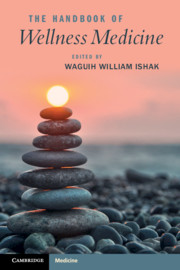Book contents
- The Handbook of Wellness Medicine
- The Handbook of Wellness Medicine
- Copyright page
- Dedication
- Contents
- Contributors
- Part I Approach to Wellness
- Part II From Illness to Wellness by Organ Systems/Disorders
- Part III Special Populations and Special Topics
- Part IV Wellness Interventions
- Part V Wellness through Optimization of Work, Love, and Play
- Book part
- Index
- References
Part II - From Illness to Wellness by Organ Systems/Disorders
Published online by Cambridge University Press: 18 September 2020
- The Handbook of Wellness Medicine
- The Handbook of Wellness Medicine
- Copyright page
- Dedication
- Contents
- Contributors
- Part I Approach to Wellness
- Part II From Illness to Wellness by Organ Systems/Disorders
- Part III Special Populations and Special Topics
- Part IV Wellness Interventions
- Part V Wellness through Optimization of Work, Love, and Play
- Book part
- Index
- References
- Type
- Chapter
- Information
- The Handbook of Wellness Medicine , pp. 57 - 176Publisher: Cambridge University PressPrint publication year: 2020

